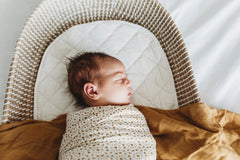Safe Sleep Policy
Safe Sleep Policy for Baby Lovey
Halo & Horns Company Policy Statement:
The purpose of this policy is to ensure the safety and well-being of infants during sleep by outlining guidelines for the use of baby loveys. Baby loveys, also known as security blankets or comfort objects, can provide comfort to infants during sleep. However, it is crucial to promote safe sleep practices to minimize the risk of suffocation, entanglement, and other hazards associated with the use of loveys.
Policy Guidelines:
1. Age Recommendation:
a. Baby loveys should only be introduced when the infant is at least 12 months old or as recommended by the child's pediatrician. This age ensures that the baby has developed sufficient head control, can roll over in both directions, and has a reduced risk of suffocation.
2. Size and Design:
a. Baby loveys should be of an appropriate size and design to minimize any risk of suffocation. They should not have long ribbons, strings, or loose parts that could potentially wrap around the infant's neck or limbs.
b. The lovey should be small enough to be easily grasped and manipulated by the baby but large enough to avoid being a choking hazard.
3. Material and Construction:
a. The lovey should be made from breathable materials to reduce the risk of suffocation. Avoid using loveys made from thick, plush fabrics that could obstruct the baby's airway.
b. All components of the lovey, including stitching and embellishments, should be securely attached to prevent them from becoming loose and posing a choking hazard.
4. Safe Sleep Environment:
a. Baby loveys should not be placed in the crib or bassinet during sleep until the baby reaches the recommended age.
b. Once the baby is old enough to have a lovey, ensure that the sleep environment remains safe. The crib or bassinet should be clear of any other loose bedding, pillows, or stuffed animals.
c. Loveys should be placed away from the infant's face, preferably near the feet or outside the sleeping area.
5. Supervision and Monitoring:
a. Caregivers should closely monitor infants when they have a lovey, especially during sleep, to ensure that the lovey remains in a safe position and does not pose any risk of suffocation or entanglement.
b. Regularly inspect the lovey for any signs of wear and tear or damage. If the lovey shows signs of deterioration, it should be replaced with a safe alternative.
6. Caregiver Education:
a. All caregivers, including parents, family members, and childcare providers, should be educated about the safe sleep policy and the associated guidelines for baby loveys.
b. Provide clear instructions on the safe use and placement of loveys, emphasizing the importance of maintaining a safe sleep environment for the infant.
Review and Updates:
This safe sleep policy for baby loveys should be reviewed periodically to ensure its effectiveness and adherence to the latest safety recommendations. Updates should be made as necessary to reflect the most current best practices for infant sleep safety.
Note: This policy serves as a general guideline. It is important to consult with healthcare professionals and follow the recommendations of pediatricians for the specific needs and development of individual infants.
Halo & Horns Company Policy Statement:
The purpose of this policy is to ensure the safety and well-being of infants during sleep by outlining guidelines for the use of baby loveys. Baby loveys, also known as security blankets or comfort objects, can provide comfort to infants during sleep. However, it is crucial to promote safe sleep practices to minimize the risk of suffocation, entanglement, and other hazards associated with the use of loveys.
Policy Guidelines:
1. Age Recommendation:
a. Baby loveys should only be introduced when the infant is at least 12 months old or as recommended by the child's pediatrician. This age ensures that the baby has developed sufficient head control, can roll over in both directions, and has a reduced risk of suffocation.
2. Size and Design:
a. Baby loveys should be of an appropriate size and design to minimize any risk of suffocation. They should not have long ribbons, strings, or loose parts that could potentially wrap around the infant's neck or limbs.
b. The lovey should be small enough to be easily grasped and manipulated by the baby but large enough to avoid being a choking hazard.
3. Material and Construction:
a. The lovey should be made from breathable materials to reduce the risk of suffocation. Avoid using loveys made from thick, plush fabrics that could obstruct the baby's airway.
b. All components of the lovey, including stitching and embellishments, should be securely attached to prevent them from becoming loose and posing a choking hazard.
4. Safe Sleep Environment:
a. Baby loveys should not be placed in the crib or bassinet during sleep until the baby reaches the recommended age.
b. Once the baby is old enough to have a lovey, ensure that the sleep environment remains safe. The crib or bassinet should be clear of any other loose bedding, pillows, or stuffed animals.
c. Loveys should be placed away from the infant's face, preferably near the feet or outside the sleeping area.
5. Supervision and Monitoring:
a. Caregivers should closely monitor infants when they have a lovey, especially during sleep, to ensure that the lovey remains in a safe position and does not pose any risk of suffocation or entanglement.
b. Regularly inspect the lovey for any signs of wear and tear or damage. If the lovey shows signs of deterioration, it should be replaced with a safe alternative.
6. Caregiver Education:
a. All caregivers, including parents, family members, and childcare providers, should be educated about the safe sleep policy and the associated guidelines for baby loveys.
b. Provide clear instructions on the safe use and placement of loveys, emphasizing the importance of maintaining a safe sleep environment for the infant.
Review and Updates:
This safe sleep policy for baby loveys should be reviewed periodically to ensure its effectiveness and adherence to the latest safety recommendations. Updates should be made as necessary to reflect the most current best practices for infant sleep safety.
Note: This policy serves as a general guideline. It is important to consult with healthcare professionals and follow the recommendations of pediatricians for the specific needs and development of individual infants.



